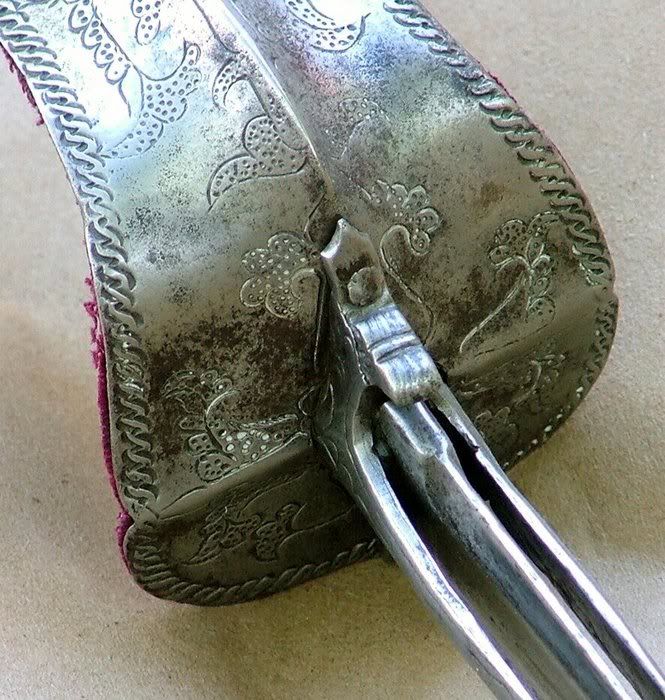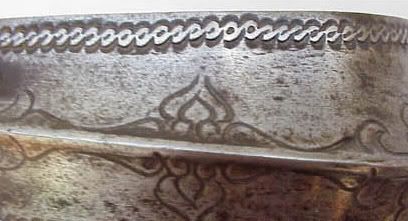
 |
|
|
|
|
#1 | |
|
Member
Join Date: Dec 2004
Location: Virginia
Posts: 520
|
Quote:
A very nice peudeueng peusangan with a hulu meu apet ( pedang type 1). I believe the pattern you talk about is just a vegetative motif. If is seen on many hulu meu apet, I will try to post some more pictures soon of some. The floral motifs seen in Aceh are very common on weapons. Geometric and vegetative motifs are often symetrical. And very often enclosed in lines or borders. While it would be an H in the latin alphabet I am pretty sure they mostly use the arabic alphabet there. I hope someone here can add more on this Maybe Utami will see this soon he is our man on the ground so to speak on these swords. Or Albert he certainly will have some good input on it. |
|
|
|

|
|
|
#2 |
|
Member
Join Date: Dec 2004
Location: Virginia
Posts: 520
|
Some images
   Some on Artzi's site http://www.oriental-arms.com/photos/...02262/ph-4.jpg http://www.oriental-arms.com/photos/...02168/ph-4.jpg http://www.oriental-arms.com/photos/...01161/ph-5.jpg http://www.oriental-arms.com/photos/...02189/ph-4.jpg Last edited by RhysMichael; 19th March 2007 at 02:33 AM. |
|
|

|
|
|
#3 |
|
Member
Join Date: Jan 2006
Location: Kent
Posts: 2,658
|
Hi Flavio,
Congrats... I really like the Pedang..  ..the influence of Hindu weapons seems unmistakable with the example you've posted. The hilt is great (very Khanda-ish) and the blade looks fantastic. ..the influence of Hindu weapons seems unmistakable with the example you've posted. The hilt is great (very Khanda-ish) and the blade looks fantastic. The blade on the Gurade is also very nice.....is it European ? My knowledge of SEA weapons could be written on a postage stamp.....but the blade on the Mandau seems quite modern, the hilt has very little wear or patina. (yesterday I posted a recent Mandau.....functional, well balanced and basic with a good forged blade...but 40+ years old) Regards David |
|
|

|
|
|
#4 | |
|
Member
Join Date: Dec 2004
Location: Virginia
Posts: 520
|
Quote:

|
|
|
|

|
|
|
#5 |
|
Member
Join Date: Dec 2004
Posts: 987
|
Regarding the mandau, we just had a very excellent talk at the Timonium seminar on the subject, which informed that the carving on the handle had very strong religious significance. The stylized motifs each represented a specific aspect of the Dyak cosmology, and the mandau as a whole was meant to represent the cosmos in a way. Erik said that sometimes months, or even a year, were taken to carve the handle.
In view of that, it seems very odd that the handle on this one is so roughly done and relatively unadorned. The lens shapes though are, I think, one of the traditional motifs - the leech. |
|
|

|
|
|
#6 |
|
Member
Join Date: Dec 2004
Location: Italia
Posts: 1,243
|
Hi all and thank you for your comments. On the Mandau: maybe from pictures it's hard to say but the blade is very nice and not crude at all with a beautiful inlaid work. I don't want to defende at any cost my piece but could be well that was collected early as the seller says: "The sword brought to the Netherlands by a Duth captain of the KPM steam package service who died in 1934. His first journey was in 1887 according to his grandson" Maybe this piece never had taken heads, as Ben would say, but I think that is quite old (early 900 at least), but i'm not an expert.
For the handle: we see also good mandaus with completly undecorated hilts, but maybe this is not the case. Just thoughts for discussion 
|
|
|

|
|
|
#7 |
|
Member
Join Date: Dec 2004
Location: Italia
Posts: 1,243
|
Thank you very much John, as usual your help is fundamental! Yes the decoration seems an H for latin alphabet, but for arabic alphabet maybe means other or nothing (just decoration). But could be that this kind of decoration was influenced by the Dutch? Just an idea

|
|
|

|
 |
|
|